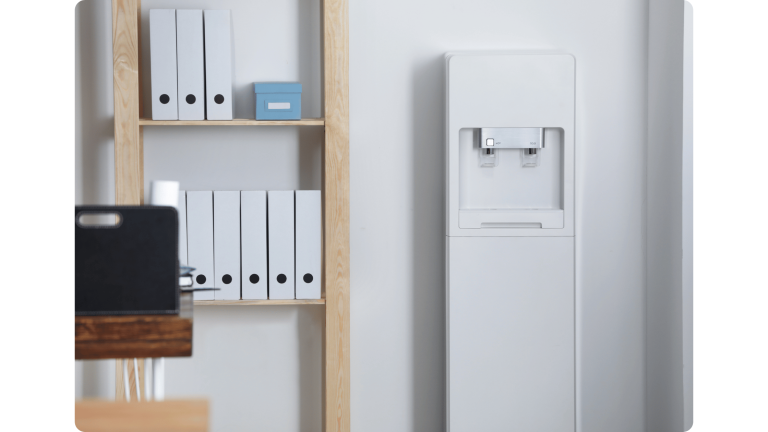
Office Storage Planning: Best Practices for Organized Workspaces
Effective office storage planning is crucial for an efficient and successful workspace. It boosts productivity and streamlines operations. This article outlines best practices for planning your office storage.
Understanding Your Storage Needs
Audit your inventory thoroughly, including documents, stationery, equipment, and resources. Prioritize accessibility by keeping frequently used items within arm’s reach and store away seldom used ones. Account for growth by ensuring storage solutions can scale with business growth.
Types of Office Storage Solutions
Efficiently organizing and managing a workspace is crucial for productivity. Choosing the proper storage solution is vital. Understanding the various types of office storage available can help businesses make informed decisions.
Filing Cabinets
Filing cabinets provide document safety and streamlined access with a range of vertical, lateral, mobile, and lockable units. They blend traditional organizations with contemporary demands and emphasize the importance of well-organized records.
Shelving Units
Shelving units are versatile storage solutions that can store and display many items. Whether you prefer an open or closed design, options are available to suit your needs.
Pedestal Units
Pedestal units, often located underneath desks, usually contain a mix of shallow and file drawers. They offer easy access to important items without leaving one’s desk.

Storage Cupboards and Credenzas
These closed units are perfect for storing items that need to be kept out of sight, such as office supplies. Additionally, the top can serve as an extra workspace or a display area for decor.
Mobile Storage Solutions
Storage units on wheels allow for easy movement of items, making them ideal for dynamic office environments that frequently reconfigure spaces.
Wall-mounted Units
Maximize your space with these wall-mounted units that efficiently store or display items, clearing up valuable floor space.
Lockers
Lockers are perfect for businesses with open office layouts, providing a secure storage space for employees’ personal belongings.
Modular Storage Systems
Businesses can customize their storage needs with adjustable solutions that can expand, shrink or reconfigure to meet changing requirements.
Specialized Storage
Specialized storage solutions are available for offices with unique needs, such as blueprint cabinets for architectural firms or media cabinets for graphic design agencies. Utilizing the proper storage solution can create a clutter-free and organized workspace. With various options, businesses can select storage solutions that cater to their operational needs and complement their office aesthetics.
Optimizing Your Workspace with Strategic Storage
The workspace is the hub of productivity and innovation for businesses. A messy and unorganized environment can hinder efficiency, creativity, and morale. Strategic storage involves designing and utilizing space to optimize workflow and productivity. Here’s a guide on optimizing your workspace with strategic storage techniques.
Evaluate and Prioritize
Make sure to prioritize items according to how often you use them. For instance, if you use an item regularly, it makes sense to keep it within reach. However, if you seldom use an item, consider storing it off-site to conserve space and tidy your storage area. By following this approach, you can ensure that your storage space remains organized and easy to navigate.
Embrace Vertical Space
Often, the focus is primarily on horizontal surfaces like desks and floor areas, but there’s potential storage space overhead:
- Install Wall Shelves: Use shelves to store books, files, or decorative items.
- Use Wall-mounted Organizers: These are perfect for stationery, tools, or any other small items that must be accessed frequently.
Consider Tall Storage Cabinets: These can house many items without consuming too much floor space.

Zone Your Workspace
The efficient workflow requires the grouping of related items in designated areas, along with the labelling of zones. Dedicate a specific printing zone for the printer, paper, ink cartridges, and related supplies. Labelling zones facilitate swift identification and ensure all items are returned to their proper place.
Modular and Adjustable Storage
Businesses are constantly evolving, and storage demands can fluctuate. Selecting adjustable shelving and modular furniture that can be tailored and reorganized to accommodate shifting item sizes and storage requirements is essential.
Declutter Regularly
You must prioritize regular maintenance to maintain an optimized workspace. You must schedule monthly clean-ups to efficiently remove unnecessary items and digitize physical papers to reduce the need for storage drastically. Failure to do so may result in reduced productivity and chaos in your work environment.
Use Multi-functional Furniture
Furniture with multiple purposes is highly advantageous, such as:
- Retain the meaning of the text
- Avoid introducing new information, sentences, or paragraphs
- Ensure vital information is not omitted from the text
- Maintain the same level of formality as the original text.
Optimize Drawer Storage
To avoid cluttered drawers, it is imperative to organize them properly. Utilize drawer organizers to compartmentalize items and clearly label drawers to avoid confusion and expedite retrieval.
Personalized Storage Solutions
Personal storage lockers and desk organizers must be provided to accommodate each person’s distinct work style.

Safety and Security Considerations
Keeping assets, data, and employees safe is essential in the modern office. As companies grow and office dynamics change, safety and security measures become even more critical. Here, we will discuss some crucial considerations for office storage.
Weight Limits: Ensuring Stability and Safety
You must avoid overloading shelves and cabinets to prevent damage and collapse. Regularly inspect units for wear and stress to ensure their stability. For added support, place heavier items on the bottom shelves.
Lockable Units: Protecting Valuable and Confidential Assets
To ensure the safety of sensitive documents or expensive equipment in an office, it is imperative to utilize key management and digital locks. Additionally, opaque or frosted cabinets can provide an extra layer of protection.
Environmentally Controlled Storage: Preserving Item Integrity
Certain items, such as electronics and documents, require specific storage conditions to maintain quality and extend lifespan. Temperature and humidity fluctuations can damage electronics, paper, and specific materials. Storage with climate control or consistent environmental conditions is recommended. Direct sunlight can fade documents and harm electronics, so ensure proper positioning in storage solutions away from sunlight or rooms with blinds or curtains. Adequate ventilation is also important to prevent overheating or moisture buildup in storage rooms, especially for electronics.
Conclusion: The Importance of Organized Workspaces
Balancing safety and efficiency is crucial in today’s evolving professional landscape. Creating a workspace that seamlessly melds functionality with security enhances productivity and fosters a work environment where employees thrive. Adhering to best practices in office storage and organization safeguards efforts and assets. These principles ensure a harmonious and forward-thinking approach to business operations.